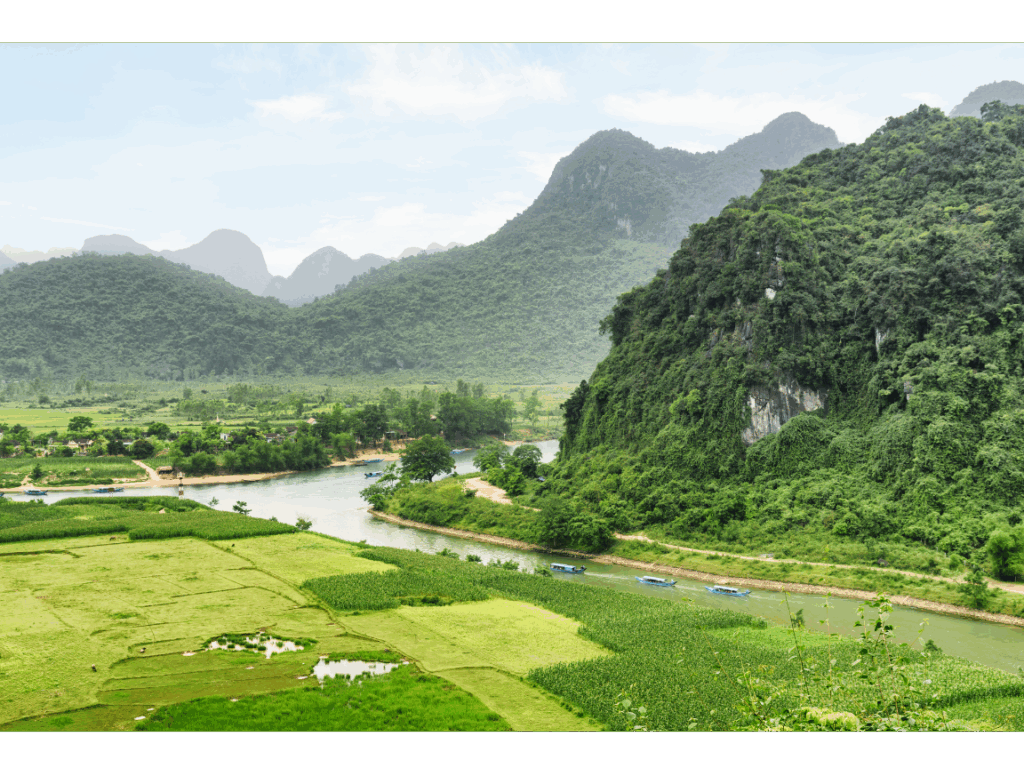
Phong Nha–Kẻ Bàng: Caves, Rivers, and Rainforest in Central Vietnam
Overview
Set in Quang Binh Province in Central Vietnam, Phong Nha–Kẻ Bàng National Park brings together extensive karst cave systems, clear rivers, and intact tropical forest. It’s a UNESCO World Heritage Site recognized for geology and biodiversity.
You’ll also find Sơn Đoòng here, the world’s largest cave—first noted by local woodsman Hồ Khanh in 1991 and surveyed by an international team in 2009. Since then the park has leaned into eco‑adventure: access to sensitive areas is limited, groups are kept small, seasons and routes follow conditions, and community‑based services play a central role. Visitor spending supports habitats and local livelihoods. We focus on experiences most travelers can actually enjoy, with options to go deeper when fitness, skills, and permits line up.
Why Phong Nha belongs on your Central Vietnam itinerary
Phong Nha lies just a few hours north of the imperial city of Hue, so it’s easy to add to a Central Vietnam trip. In a compact area you can paddle calm sections of the Son and Chày rivers, walk boardwalk caverns, trek jungle valleys, zip into swimming coves, and cycle quiet farm lanes in Bong Lai. Managed access and small‑group touring keep trails and caves uncrowded. You can set the pace—from family‑friendly half days to multi‑day treks.
What to do
- Hang Én (Swallow Cave) overnight: A jungle approach leads to a vast chamber with a sandy beach. Expedition feel without complicated logistics. Good step up for fit travelers.
- Paradise Cave & Phong Nha Cave: Straightforward half‑day options. Paradise follows an easy boardwalk with big formations; Phong Nha is reached by boat on the Son River. Works well for mixed‑ability groups.
- Dark Cave & Chày River: Zipline, a short mud‑chamber wade, and kayaking. High‑energy but adjustable.
- Kayaking or SUP: Calm stretches on the Son or Chày—sunrise and late afternoon are best for light and cooler temps.
- Countryside cycling (Bong Lai Valley): Flat to rolling roads past farms and karst cliffs. Add a farm lunch or coffee stop.
- Day treks & wildlife nights: Stream crossings, viewpoints, and after‑dark walks with a guide. We’ll match the route to your fitness and the season. If you want a private guide or a slower day between big ones, we can set that up.
Sustainability you can see
Phong Nha takes a conservation‑first approach that’s visible on the ground. Access to sensitive caves is limited by daily permits and capped group sizes, and some zones are guide‑only with defined routes so visitors stay on durable surfaces. Seasonal closures are normal during high water and storm periods, and we plan around these windows rather than pushing a route that isn’t safe. On the people side, community‑based tourism is built in: homestays, village kitchens, boat drivers, and locally run services earn directly from your visit, which helps keep money in the area and supports forest protection and training for guides and rangers. The trade‑off is a bit more planning; the payoff is quieter trails, better safety, and a place that still feels wild.
A place with history
You’ll see reminders of earlier eras—from Champa‑period inscriptions to sites tied to the Ho Chi Minh Trail. We can add short stops at small museums and memorials so there’s context between adventure days.
When to visit
- Dry season (Feb–Aug): Best overall for caving, trekking, and river days. Expect heat; mid‑day breaks help.
- Rainy season (Sep–Jan, heaviest Oct–Dec): Higher water and some closures. It’s quieter and very green; flexibility is important and we’ll provide alternatives.
Getting there
- By air: Fly to Dong Hoi (VDH) from Hanoi or Ho Chi Minh City. Private transfer to Phong Nha takes ~45–60 min.
- By rail: Dong Hoi is on the north–south line. We can book soft‑berth sleepers or day seats and meet you on arrival.
- By road:
- Hue → Phong Nha: ~3.5–4 hrs by private vehicle.
- Da Nang/Hoi An → Phong Nha: ~5–6 hrs depending on route and stops. We run door‑to‑door transfers so you don’t have to juggle buses or taxis.
Sample Itinerary (4-6 Days)
Day 1: Dong Hoi arrival → riverside check‑in → sunset paddle.
Day 2: Paradise Cave + forest walk → countryside cycling in Bong Lai Valley.
Day 3: Dark Cave zipline, mud chamber & Chày River kayak → farm dinner.
Day 4–5: Hang Én overnight (trek in, camp, trek out) or gentler multi‑cave combo + wildlife night walk.
Day 6: Private transfer to Hue (or Da Nang/Hoi An) with optional scenic stops.
Practical notes
- Permits & closures: We handle permits and check conditions daily. If something closes, we swap in a comparable option.
- What to bring: Light long sleeves, sun cover, electrolytes, quick‑dry layers, river shoes or sandals that drain, and a dry bag for phones.
- Cash & connectivity: ATMs are limited in Phong Nha town; bring some cash. Coverage is spotty on treks.
- Etiquette: Ask before photographing people, keep noise down in caves, and follow the guide—small actions make a difference.
Ready to plan?
Tell us your dates, group size, and the kind of days you want (easy, moderate, or push a bit). We’ll build a custom plan and handle transport from Dong Hoi, Hue, or Da Nang. If you want us to add time in Hue or Hoi An, we can do that too.

Share your dates and interests—we’ll send a tailored proposal that fits your pace and budget.

